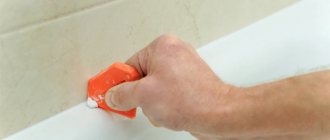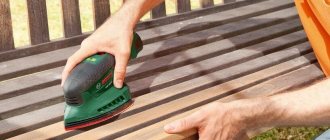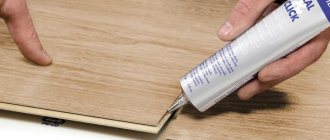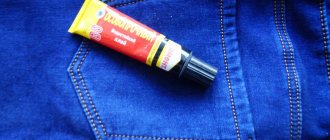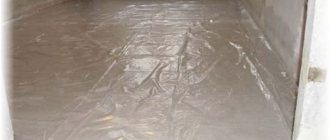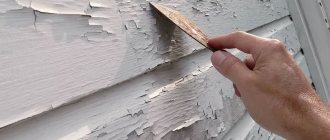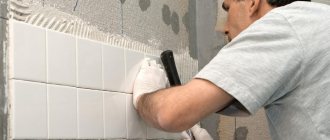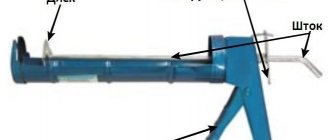Silicone sealing material should always be kept in your home.
Since living spaces are characterized by constant contact with water, situations from time to time arise when water penetrates into various cracks, joints, seams that form between ceramic tiles, tiles, in the bathroom, in the kitchen when washing dishes or in the pool.
It is thanks to silicone sealant that water does not get into vulnerable places, as a result of which there is no fungus, various bacteria and other harmful substances in the house.
Sealed silicone materials are quite easy to use, but you need to be very careful with them, as they are extremely toxic and harmful to health.
Once on any exterior, the sealed silicone substance will be very difficult to remove.
This is due to the chemical composition of the substance, its ability to be absorbed into any surface.
Of course, there is a possibility of destroying the glue, it all depends on the type of material of the exterior and the statute of limitations of the divorce.
Description of composition
The main component of the sealant is silicone. This is a multifunctional soft, plastic substance, the main function of which is to seal various holes.
Silicone sealants have a viscous adhesive colorless or white base, which has a high ability to dry and acquire a dense, uniform structure.
You need to be extremely careful when using it, because they are very difficult and difficult to remove even if you use various solvents or mechanically influence it, since this is how silicone sealant performs its main function of protection.
Quite often, a sealant silicone substance is used at home to seal holes in:
- bathroom;
- windows;
- aquariums;
- refrigerators;
- interior doors;
- ovens;
- toilet rooms.
It must be remembered that cleaning the sealant takes quite a long period of time and effort, so you must use this chemically complex material carefully.
How to deal with dried silicone at home
This problem often has to be solved at home. You have to get rid of frozen silicone by any means. To solve this problem, it is best to use special organic solvents. They need to be applied to the frozen silicone sealant, wait a few minutes, and then remove the softened mass with any sharp object.
As mentioned above, a special remover and chemicals, which are divided into several groups, according to the area of application, perfectly combat frozen silicone.
However, you must always remember that any remover contains acid, which can spoil the object being cleaned. For example, you cannot clean leather objects, such as a chair, with this remover. In addition, the remover can ruin the acrylic bathtub.
Sealant removal methods
And yet it is possible to destroy silicone glue. The following methods of disposal of this material exist:
- flushing;
- erasure;
- scraping and cutting;
- using chemicals to soak the material.
In some circumstances, it is better to remove the sealant mechanically, cutting off and cleaning the silicone adhesive from the outside over and over again.
In other cases, as a rule, in most cases a special chemical is used to remove silicone.
A logical question arises - why remove the sealant if it is transparent or white and is not visible on the surface? We will answer that, in addition to other properties, it has the ability to darken and become dirty over time.
And of course, as a result of constant contact with water in the bathroom or kitchen, there is a possibility that the adhesive substance will come off and, naturally, it must be replaced to protect the surface.
Characteristics
Weight, kg 0.101 Volume (l) 0.08 Manufacturer's warranty (years) 2 Packaging type Cartridge Product type Silicone remover
Prices and availability may vary. Please check the exact cost and availability of goods in stores.
156.00 Painting tape Dexter 48 mm x 50 m 375.00 Painting tape 48 mm x 50 m, 3 pcs. 220.00 Super-rag Unicum non-woven fabric 140 pcs. 255.00 Garbage bags 220 l black 10 pcs. 140.00 Napkin, 35×35 cm, microfiber, 4 pcs. 293.00 Waffle fabric roll 10 m cotton 498.00 24.90.90 Covering film in dispenser 2.7x20 m 118.00 Protective film 500x400 cm 3 pcs. 47,00 94.00,00 Degreaser 0.5 l 41,00 82.00,00 White spirit 0.5 l 218,00 Dexter sealant removal/leveling kit 58,00 Matrix sealant spatula 208,00 2,600.00,00 Tytan Professional silicone sealant new sanitary color white, 80 ml 252.00 900.00 .00 Sealant Moment Sealant sanitary, transparent, 280 ml 208.00 2 600.00 .00 Sealant Tytan Professional silicone sanitary colorless, 80 ml 251.00 Gun for sealants and mounting adhesive Dexter half-body 347.00 103.58 .58 Curb tape Unibob 38 mm x 3.35 m 28.00 Set of spatulas Sibrtech white rubber 40/60/80 mm, 3 pcs. 151.00 Gun for sealants and mounting adhesive reinforced skeleton 237.00 Multi-tool for silicone Bison Multi Tool 455.00 135.82.82 Unibob curb tape 60 mm x 3.35 m 100.00 Painting tape 48 mm x 50 m Show all Related products
Mechanical methods
In order to clean the adhesive substance mechanically, you need to have simple tools with you that are always at hand in any home: sandpaper, a sharp knife, a metal utensil brush, pumice stone, a scraper or a spatula.
We offer some tips for working with deletion:
- An ordinary spatula is a wonderful tool for removing glue. It is intended for all surfaces - the main thing is that there are no damage or various nicks on the edges, since they have the ability to damage the surface of the material being cleaned without the use of a solvent. You can work with the edges of a spatula for convenience.
- An office or professional knife perfectly cleans raised tubercles of dried glue without the help of a solvent. Here it is only important to be careful not to cut yourself on the sharp blade of the knife.
- Bank card. Oddly enough, it is bank plastic that can clean treated surfaces from glue without the help of a solvent, provided the damage is minimal and small in size. Perfectly removes stains from tiles or glass parts. If you add a special solvent before cleaning, that is, soften the area being treated, then the card can easily remove excess unnecessary materials.
- Razor blade. A good tool, but not suitable for working on all surfaces, especially plastic, as it easily damages and leaves scratches from a sharp blade. And you should always work with gloves for safety reasons.
When you have in your arsenal an ordinary sandpaper, a kitchen brush or a pumice stone in addition to soda, salt, and powder for cleaning the bathtub, it’s not a problem. This is enough to defeat pollution.
To do this, first cut off the rough sections of silicone glue with a knife, then wet the rag well, squeeze it out and add any of the abrasives listed above, doing this with slow circular movements. Then wash the loose particles with plain water.
Remove from various surfaces
When cleaning with one product on different surfaces, the result will be different, since not all surfaces are able to withstand the effects of individual components. Therefore, when removing silicone from different coatings at home, the type of surface is taken into account.
Plastic
Plastic surface is a delicate type, as it has poor contact with chemical compounds. To wash silicone contamination from plastic, special washing mixtures are used, for example, Permaloid.
The surface of the package must contain information about the intended use of the product for plastics.
It is also possible to use hydrochloric acid.
Glass
The glass plane is hard and reacts well to solvents. The sealant itself is not very absorbent, so white spirit, purified gasoline, and kerosene will help remove the silicone layer. Depending on the product, the time allocated for cleaning varies.
Tile
The tile has a glossy coating on the surface that reacts to solvents. To clean this coating, products with abrasive components are not used. Also, white spirit is not used for low-quality ceramics. It is better to buy special solutions for the work or use kerosene.
Skin of hands
If, when applying silicone sealant, it gets on the skin of your hands, then you should not delay cleaning. It is better to immediately apply a piece of polyethylene to the stained area, hold it for 5 seconds, and quickly remove the film along with the adhered layer of acryplast. Next, hands are washed with soap and water.
The second method is an alcohol or saline solution. The area is moistened with the solution and wiped with a clean cloth.
Textile
If sealant with acidic components gets on clothing, then acetic acid is used to remove it. To do this, the fabric is wetted with acid, then a mechanical method is used.
The same method uses an alcohol solution.
Chemical methods
In specialty supermarkets there is a huge range of sealant solvents.
All of them are conventionally divided, but one and two-component. Everything is determined by the structure of the substance and the type of silicone for which they are intended. We recommend using single-component ones at home, as they are difficult to dilute in precise proportions. In general, solvents are divided into acidic and neutral (alcohol, amine, oxide, amide).
The best acid solvent to use perfectly peels off the buildup and is washed off with vinegar essence. Silicone sealant has a familiar smell of vinegar; alcohol sealant dissolves in 96% technical or food grade alcohol.
Other adhesives are removed with solvent 647, solvent, acetone, white spirit, and regular gasoline.
The most common liquids for cleaning (solvents) from any sealant are “Penta 840″, Antisil, Silicon-Entferner. They are the ones who clean away large stains and old seams before applying new ones.
The only drawback of solvents is that they are powerless against stains of polyurethane foam sealant, which can really be destroyed mechanically.
How to dilute (dilute) silicone sealant to make it more liquid?
Silicone sealant in a tube, its consistency is not satisfactory, you need a more liquid silicone sealant than can be diluted so that it becomes liquid and more fluid.
I would like to note right away that there are different silicone sealants, universal, sanitary, silicone sealant for aquariums, etc.
There are one-component and two-component silicone sealants (although this sealant has a complex composition and is more often used in production than in everyday life).
In addition to their different scope of application, they are also different in composition.
There are acidic silicone sealants with a characteristic and pungent odor of vinegar; such silicone sealant contains acetic acid.
There are neutral silicone sealants in different bases, alcohol, amide.
That is, first read the information on the tube and then select a thinner (solvent) with which you can make the sealant more liquid.
The proportions are selected experimentally, because the required consistency may be different and the amount of sealant may be different.
It is unlikely that you will squeeze out the entire tube and dilute it at once.
If it is an acidic silicone sealant, then I diluted it to a liquid state with 70% vinegar essence, add the essence, mix.
If it is an alcohol-based silicone sealant, then you can dilute it with alcohol.
Well, in general, silicone sealant is diluted with the following solvents (in addition to acid):
Gasoline will also work, but you need clean gasoline for lighters.
Acetone is another option.
You can buy a wipe (also known as a remover, also known as an anti-silicone) of Novol silicone at an auto store.
You can dilute it to a more liquid state like this,
How to remove sealant in the bathroom
It is very difficult to remove sealed silicone in the bathroom or on tiles.
As a rule, they use a sharp knife, which is used to cut the entire length of the seam, then I forge it from below and tear off the material. After this procedure, it is necessary to additionally clean the traces of sealant application, because it will be quite noticeable. Clean it with:
- vinegar;
- salt;
- pumice;
- abrasive;
- solvent.
It is important that the removal occurs before it dries and it is advisable to use vinegar for this purpose. If the glue has dried, apply acetic acid overnight.
You need to be careful when working with an acrylic bathtub, because this material is quite sensitive to various scratches.
To do this, soak the stain in white spirit for about a quarter of an hour and carefully scrape it off with a wooden scraper. Next, lightly wipe with a dry cloth and rinse with water.
Silicone and liquid state
Silicone-based sealant can be diluted or diluted with several substances. The main thing is that the sealant retains its properties. It is prohibited to use toluene for these purposes - silicone is not a harmless substance, and in combination with toluene it leads to chemical poisoning.
Construction gun for easy application of sealant
You can not lose quality and dilute the silicone to a liquid state using silicone rubbing. It is important to maintain the proportion: 1: 6 – rubbing: construction silicone.
You can also dilute the sealant with silicone oil or lighter gasoline. It's better to use the first option.
Cleaning tiles
Cleaning ceramics is much easier and simpler, since it is smooth, even, and it is almost impossible to leave scratches on it.
To begin with, the protruding silicone glue is cut off with a knife or razor. Then rub gasoline or kerosene with a rag until the silicone softens.
If the stains are not flammable, use white spirit; in the most difficult cases, use Penta 840.
Be sure to test it on an inconspicuous area of the tile for a chemical reaction, because this solvent may affect the front side of the tile by dulling or losing its gloss.
In this regard, it is important to remember some rules:
- expensive and high-quality slabs need to be cleaned using a wooden scraper;
- It is advisable to use a knife, not a razor;
- keep the solvent for no more than three hours until the silicone forms a jelly;
- Clean dark spots with salt.
Take care of your hands
You can deal with a stain that has not had time to dry with sealant at home only immediately, before it has time to harden. Such work requires compliance with safety precautions and must be carried out with gloves. But there are times when the paste gets on your hands.
There are several ways to clean them:
- You need to rub your hands with a plastic bag. The glue will just stick to it. All that remains is to wash your hands. The procedure can be repeated several times.
- Water is mixed with vinegar in a 1:1 ratio. Wash your hands in this solution, after which they are thoroughly washed in running water and soap.
- You can also get rid of fresh stains on your hands using hot water. Hands are placed in the container and kept in hot water for several minutes. Then you need to soap your hands well and rub them with a pumice stone.
- You can also use acetone, gasoline or a special liquid designed for removing varnish. You need to generously moisten cotton wool with this solvent and wipe your hands well.
In any case, when working with solvent or remover, you should always protect your hands. You can wear gloves, if you don’t have them, you need to soap your hands well and wait until they dry. The soap film that forms on the skin will not allow the sealant to adhere firmly to the skin.
Cleaning plastic
Plastic materials are cleaned much easier and faster than all others, since the adhesion to silicone is too weak. Before this, a solvent is applied to pipes, pallets, and sewers for 60 minutes, then cleaned of the molten mass.
Everything else is washed off with water and an abrasive agent. Plastic shower cabins are washed off with a special product for such cases, Dow Corning OS-2. Application time: 30 minutes, then removed with a spatula.
This product is intended for difficult to remove stains and is absolutely safe for plastic.
Glass and mirror cleaning
Stains are removed from glass and mirrors quite quickly and easily.
Sometimes a sharp knife or blade is enough to scrape off excess silicone and then wash with detergent. Finally, the glass is washed with window cleaner. Handle the knife carefully so as not to damage the surface of the glass. If the stains are old and difficult to remove, use white spirit.
But under no circumstances should you use gasoline, because fuel leaves iridescent spots on the glass that practically cannot be removed.
Features of removal from various surfaces
When removing sealant, you need to consider the type of surface:
- Glass. The use of such glue when installing windows or repairing an aquarium can lead to contamination of the glass. A universal solvent that does not damage glass is White Spirit. The method of application is simple: moisten a sponge or cloth with the substance, apply it to the dirty area, after a while pick up the softened silicone with the tip of a knife, remove it, wash with water and soap.
- Tile. Exposure of tiles to chemical solvents can be harmful to the material. A cotton pad soaked in gasoline will come to the rescue. The sealant will become soft and the glue will be easily removed.
- Plastic panels, countertops. Surfaces should be treated immediately as soon as the glue gets on them. Kerosene or refined gasoline will do. The hardened composition is almost impossible to remove without damaging the coating.
- Things, skin . Liquids containing alcohol can easily remove multi-purpose adhesive sealant from fabric and hands. For products that contain acid, you will have to use a vinegar solution. The product is removed from clothes with a concentrated solution, and from skin - with vinegar diluted with water.
Removing Countertop Stains
To decide on the method of cleaning the countertop, you need to find out what material it is made of.
If it is porcelain tile, there will be no problems with removal - stains can be removed in any way:
mechanical, chemical, mixed, because this type of material is very difficult to damage or leave scratches on it.
A plastic tabletop is a more difficult option for carefully cleaning silicone, as it can easily be scratched and damage the integrity of the surface.
After treatment, stains may remain, so you should first test the solvent on an inconspicuous area to see if it reacts with the plastic. After the silicone has dissolved, it is removed with a scraper and washed with a washing abrasive.
How to wash clothes
When working with sealants, it happens that the material penetrates the surface of the clothing.
It would be good to remove it immediately before it hardens. In this case, the stretched material is touched with a hard thin object, then the silicone glue is removed. But there are times when the sealant has already dried.
Then they act differently. First, the stain is wiped with vinegar, then washed by hand. Alternatively, you can remove the stain with alcohol - to do this, soak a toothbrush in alcohol and clean the clothes. This is very easy to do, because the sealant curls up into a lump.
Silicone removal process
Almost all solvents are similar in the process of interaction with the sealant. Since the composition has an aggressive effect on the surface and humans, they take care of their safety. Provide good ventilation, wear gloves and a respirator. Before use, try the effect on a sample. When the check is completed, proceed to the following steps:
- The selected product is applied to the contaminated surface. The manufacturer indicates the application method on the solvent. To do this, use a washcloth or apply the product to the stain.
- The instructions indicate the time of exposure to the solvent, it is maintained. It varies from 1 to 24 hours depending on the degree of drying.
- The contamination turns into a gel-like state, after which it is removed. Most often, a dry cloth is used for this. But there are exceptions to the rules. Using “Silikill”, dissolved dirt is removed with a damp, soapy cloth.
The solvent acts faster if the dissolution procedure is performed in a dry room. Remove the remaining aggressive composition with a damp sponge. This procedure is mandatory, otherwise solvent residues will continue to corrode the coating or get on the skin. After cleaning, the work area is ventilated.
Before looking for a means to dissolve silicone sealant, ask yourself the question of feasibility. There is no point in removing frozen sealant on a plasterboard sheet, since this will soften the material itself that is being puttied. If the drop is large, then it is cut off at the root and then hidden under a layer of plaster.
Wetting sealant from hands
If the product ends up on your hands, just wash it with regular rock salt.
Add salt to a bowl of warm water, immerse your hands and cleanse with pumice. The procedure is repeated about three times until the product is completely washed off.
To wash off the silicone, you can use regular laundry soap and pumice.
Useful tips
Heating or freezing are considered methods for cleaning any surfaces from glue.
If you use heating the exterior, then apply vinegar to the glue, then cover it with a sheet of paper, then run an iron over the surface. The freezing method is more suitable for cleaning clothes. It is placed in a bag, then in the freezer for three hours, then the glue is cleaned with a spatula.
Small stains are removed using hydrogen peroxide, a kind of solvent. You should be careful when working with chemicals.
To do this, be sure to use gloves and work clothes. As an option for clean work, tape is applied to the surface to be treated to avoid silicone glue getting into unnecessary areas.
How to dissolve dried sealant
An alcohol solution will help dissolve the acryplast seam. In this case, it is applied directly to the substance or the thing is soaked until the stain is completely softened.
If the silicone sealant contains acids, then a 70% mixture of acetic acid can dissolve it.
When carrying out dissolution with these means, constant ventilation is carried out indoors. When working, IZ means are used. The skin of the hands should be protected with gloves, the respiratory system with a respirator.
Dissolution is carried out by applying the material to the silicone seam. After an hour, a jelly-like mass will appear instead of a solid layer. It can be removed with a rag or washcloth.
Organosilicon masses leave fatty traces on the surface, which are washed off with dishwashing balm.
